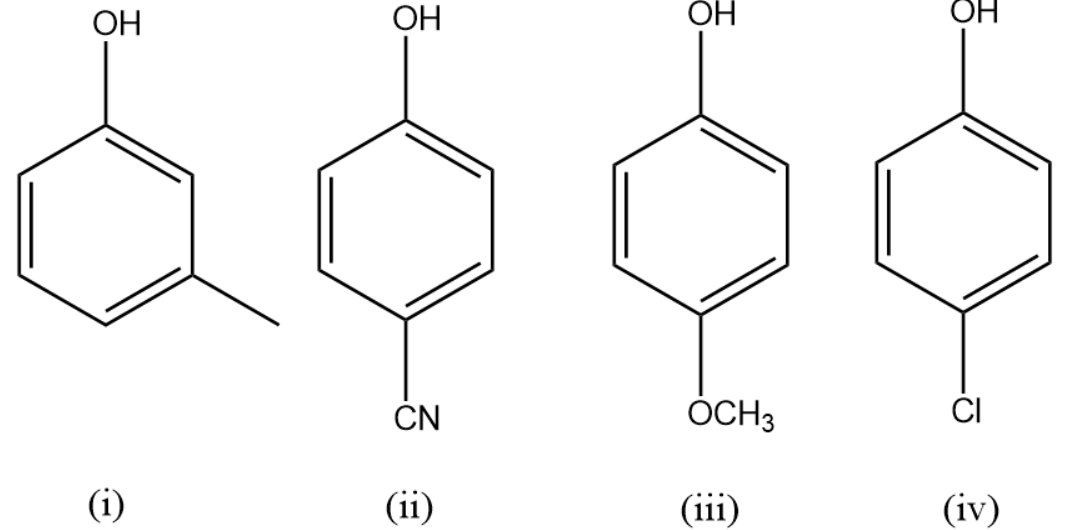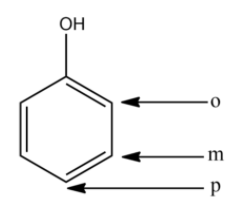
Increase order of acidic strength of given compounds is :

(A) (ii) < (i) < (iv) < (iii)
(B) (i) < (iii) < (iv) < (ii)
(C) (i) < (iii) < (ii) < (iv)
(D) (iii) < (i) < (iv) < (ii)
Answer
116.4k+ views
Hint: The four organic compounds have the hydroxyl group in common. The acidic strength of the compounds can be determined by the stability of the conjugate base formed. Only when the conjugate base formed is stable, the hydrogen ion will be released easily. The groups attached will contribute to either stabilizing or destabilizing the negative charge after deprotonation.
Complete step by step solution:
Electronic factors are the factor that influences carious organic reactions and rearrangements. Electronic effects are significantly observed in organic aromatic compounds.
Electronic factors are:
- Inductive effect
- Resonance
- Mesomeric effect
- Electromeric effect
- Hyperconjugation.
We will now identify at which position of the aromatic ring, the following effect is observed.

In the above compound,
- o stands for ortho-position
- m stands for meta-position
- p stands for para-position
In compound (i) the anion of the compound or the conjugate base is destabilised only by inductive effect as the methyl group is attached at the meta position.
In compound (ii) the conjugate base is stabilised by the cyanide or nitrile group attached at the para position as it withdraws electrons from the benzene ring
In compound (iii) the conjugate base is destabilised by the ether group attached at para-position as the oxygen atom increases electron density in the ring making it unstable.
In compound (iv) the conjugate base is mildly stabilised by the halogen atom attached at the para position.
Therefore, the increasing order of acidic strength of the given compounds is (iii) < (i) < (iv) < (ii).
The correct answer is option (D).
Note: Resonance effect is mainly observed in the ortho and para position of the aromatic ring and the only significant electronic effect observed at meta position is the inductive effect. Resonance has much more priority than inductive effect while determining the acidic strength of phenols or carboxylic acids.
Complete step by step solution:
Electronic factors are the factor that influences carious organic reactions and rearrangements. Electronic effects are significantly observed in organic aromatic compounds.
Electronic factors are:
- Inductive effect
- Resonance
- Mesomeric effect
- Electromeric effect
- Hyperconjugation.
We will now identify at which position of the aromatic ring, the following effect is observed.

In the above compound,
- o stands for ortho-position
- m stands for meta-position
- p stands for para-position
In compound (i) the anion of the compound or the conjugate base is destabilised only by inductive effect as the methyl group is attached at the meta position.
In compound (ii) the conjugate base is stabilised by the cyanide or nitrile group attached at the para position as it withdraws electrons from the benzene ring
In compound (iii) the conjugate base is destabilised by the ether group attached at para-position as the oxygen atom increases electron density in the ring making it unstable.
In compound (iv) the conjugate base is mildly stabilised by the halogen atom attached at the para position.
Therefore, the increasing order of acidic strength of the given compounds is (iii) < (i) < (iv) < (ii).
The correct answer is option (D).
Note: Resonance effect is mainly observed in the ortho and para position of the aromatic ring and the only significant electronic effect observed at meta position is the inductive effect. Resonance has much more priority than inductive effect while determining the acidic strength of phenols or carboxylic acids.
Recently Updated Pages
How to find Oxidation Number - Important Concepts for JEE

How Electromagnetic Waves are Formed - Important Concepts for JEE

Electrical Resistance - Important Concepts and Tips for JEE

Average Atomic Mass - Important Concepts and Tips for JEE

Chemical Equation - Important Concepts and Tips for JEE

Concept of CP and CV of Gas - Important Concepts and Tips for JEE

Trending doubts
JEE Main 2025: Application Form (Out), Exam Dates (Released), Eligibility & More

JEE Main Login 2045: Step-by-Step Instructions and Details

JEE Main Chemistry Question Paper with Answer Keys and Solutions

Learn About Angle Of Deviation In Prism: JEE Main Physics 2025

JEE Main 2025: Conversion of Galvanometer Into Ammeter And Voltmeter in Physics

JEE Mains 2025 Correction Window Date (Out) – Check Procedure and Fees Here!

Other Pages
NCERT Solutions for Class 11 Chemistry Chapter 7 Redox Reaction

NCERT Solutions for Class 11 Chemistry Chapter 5 Thermodynamics

NCERT Solutions for Class 11 Chemistry Chapter 8 Organic Chemistry

NCERT Solutions for Class 11 Chemistry Chapter 6 Equilibrium

NCERT Solutions for Class 11 Chemistry Chapter 9 Hydrocarbons

Equilibrium Class 11 Notes: CBSE Chemistry Chapter 6




